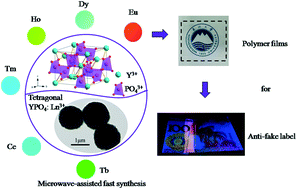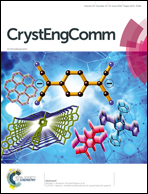Multi-color emission in monodispersed spheres of tetragonal yttrium phosphate: microwave-assisted fast synthesis, formation mechanism, temperature-dependent luminescence, and application in anti-fake labeling†
Abstract
Well-dispersed uniform spheres (∼0.7–1.5 μm in diameter) of YPO4 and (Y,Ln)PO4 (Ln = Eu, Tb, Dy, Ho, Tm, Ce, and Eu/Tb) tetragonal phosphate hydrates have been directly synthesized via microwave-assisted processing. The polycrystalline spheres, which are made of confined 10–17 nm nanocrystals, are direct solid solutions rather than a mechanical mixture of individual particles. Their growth follows an aggregation process, maintaining the composition of the material. The phosphate hydrates converted into anhydrous tetragonal materials via calcination, and the spherical shape and excellent dispersion of the original particles were well retained up to 1000 °C. Upon UV excitation, the YPO4:Ln3+ samples exhibit characteristic emissions of Ln3+ (Ln = Eu, Tb, Dy, Ho, Tm, and Ce) and yield red, green, near white, green, blue, and blue-green emissions, respectively. The color-tunable emissions (from green to red) can be varied by increasing the Eu content, and the Tb3+ → Eu3+ energy transfer process was observed for the tetragonal phosphate in the Y/Tb/Eu system. The efficiency of the Tb3+ → Eu3+ energy transfer was discovered to be ∼28% for (Y0.88Tb0.02Eu0.10)PO4. The thermal stability of (Y0.88Tb0.02Eu0.10)PO4 is lower than that of (Y0.98Tb0.02)PO4 and (Y0.95Eu0.95)PO4. Thus, the 5D4 → 7F5 transition of Tb3+ at 546 nm splits into  → 7F5 (at ∼538–546 nm) and
→ 7F5 (at ∼538–546 nm) and  → 7F5 (at ∼557 nm) transitions during the heating process. This phenomenon has been ascribed to the variation of the Tb3+ crystal environment. The
→ 7F5 (at ∼557 nm) transitions during the heating process. This phenomenon has been ascribed to the variation of the Tb3+ crystal environment. The  energy level gradually shifts to a higher one at an elevated temperature, inducing more and more excited electrons transferring from the higher
energy level gradually shifts to a higher one at an elevated temperature, inducing more and more excited electrons transferring from the higher  energy level to the lower
energy level to the lower  one via nonradiative relaxation. Therefore, an enhanced emission intensity at ∼557 nm (
one via nonradiative relaxation. Therefore, an enhanced emission intensity at ∼557 nm ( → 7F5 transition) and a weakened one at ∼538–546 nm (
→ 7F5 transition) and a weakened one at ∼538–546 nm ( → 7F5 transition) were observed. (Y0.95Eu0.05)PO4/PVA transparent films were successfully fabricated by solution casting, and they exhibit both outstanding flexibility and high transmittances of ≥83% in the 400–850 nm region. The hybrid films can be coated on paper money for anti-fake labeling applications.
→ 7F5 transition) were observed. (Y0.95Eu0.05)PO4/PVA transparent films were successfully fabricated by solution casting, and they exhibit both outstanding flexibility and high transmittances of ≥83% in the 400–850 nm region. The hybrid films can be coated on paper money for anti-fake labeling applications.



 Please wait while we load your content...
Please wait while we load your content...